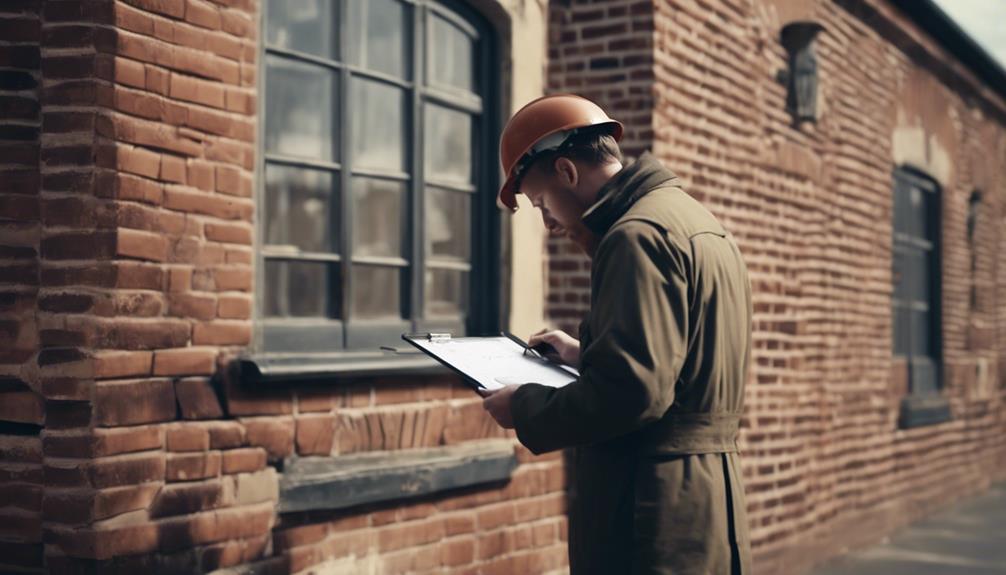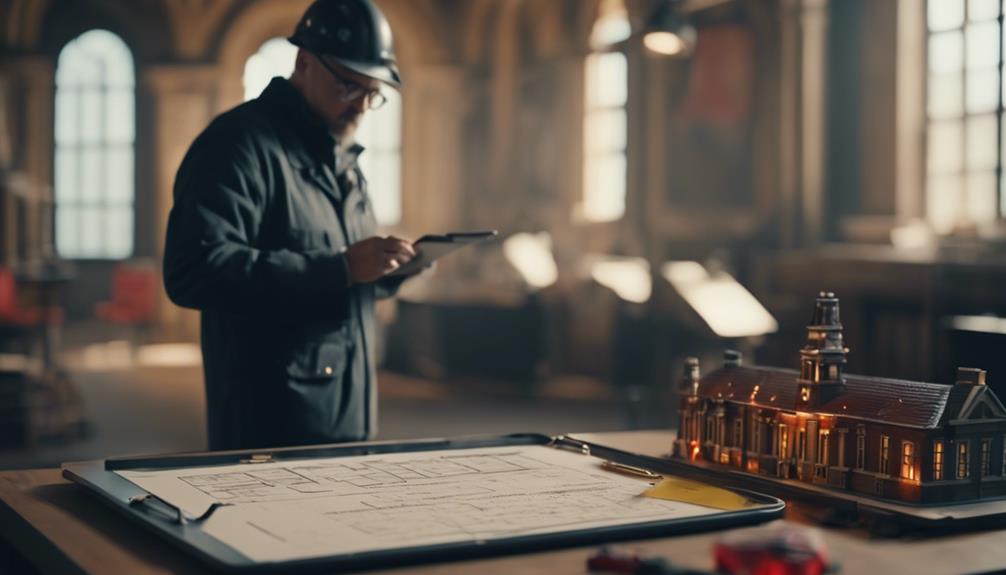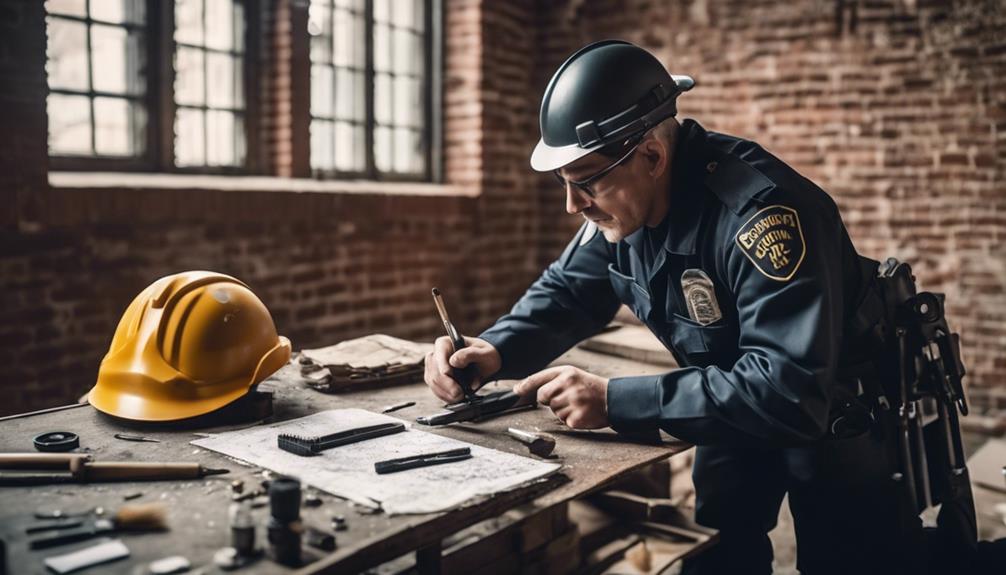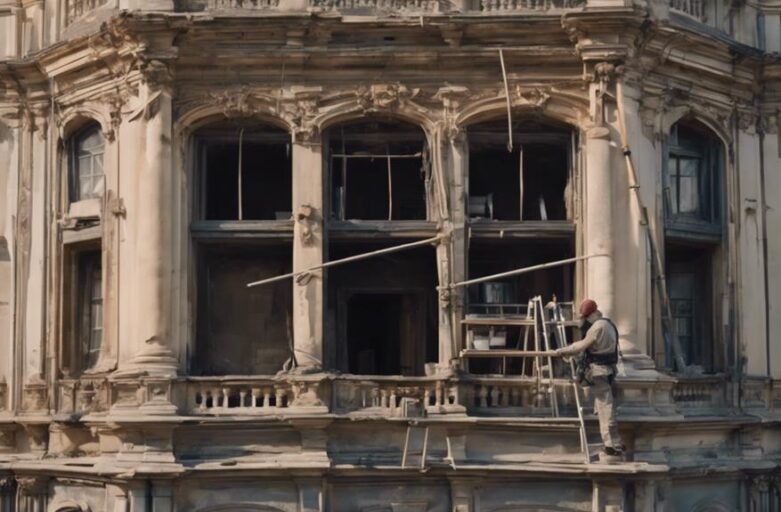Preserving old buildings is like saving pieces of history. To do this, you first need to know why that building is important. The Secretary of Interiors' rules guide us on how to take care of these special buildings.
There are different ways we can save a building, like preserving it as it is, fixing it up, restoring it back to its old glory, or rebuilding it from scratch. We need to make sure these places can be visited by everyone, while also following the law. We should try to use earth-friendly ways to keep them good.
It's a tough job to keep the building's old charm while also making it work for today's world, but it's definitely possible. Remember, this is just the start, there's a lot more to learn about preserving history.
Key Takeaways
Preserving old buildings is like keeping a part of history alive. It's done in several ways:
- We can keep a building just like it was, honoring its past life. This is like taking care of a precious antique.
- Sometimes, we need to make changes. But we do it carefully, so we don't lose the building's historical flavor. It's like giving an old piece of furniture a new coat of paint, but not changing its style.
- Another way is to take the building back in time, making it look like it did when it was new. It's like restoring an old painting.
- If a historic building is lost, we can rebuild it. We use the original design, and it's like having a history lesson you can walk through.
- No matter how we preserve, we must follow rules. These rules are about safety and making sure everyone can use the building.
So, preservation is like a careful dance between the past and the present, making sure we don't step on the toes of history.
Understanding Historic Property Significance
When we talk about historic properties, we're not just talking about very old buildings. Instead, these are special places that carry important stories from our past. To be considered historic, a property must meet certain standards regarding age, condition, and significance. You can find these historic places listed on the National Register of Historic Places.
These aren't ordinary old buildings – they're like special treasure chests full of history! Each one is important for different reasons. Maybe it was part of a major historical event, or perhaps it perfectly shows what life was like during a certain time period. These buildings are more than just stones and wood – they're a way for us to connect with our past.
Keeping these properties in good shape is super important. This is where the Secretary of the Interior's Standards come in. By following these rules, we make sure the historic parts of these properties are kept safe. This way, future generations can also learn about our shared history. One of the most important rules is about the age of the building. This makes sure that only truly historic buildings are protected.
Federal and State Designations
When we see old buildings and places, it's important to understand that the government plays a big role in keeping them safe. Think of it like a superhero movie, where the federal and state government are heroes protecting these historic places.
There's something called the National Register of Historic Places. This is a list made by the federal government of really important buildings. It's like a gold star sticker that says, "This place is super important to our country's story."
Then, each state has something called a State Historic Preservation Office. They're like local superheroes, making sure historic places in their state are safe and remembered.
The cool part is that these designations don't just protect these places. They also help out by offering things like money grants, tax benefits, and expert advice. Here's a quick snapshot:
| List | What it offers |
|---|---|
| National Register of Historic Places | Gold star recognition, protection, money grants |
| State Historic Preservation Offices | Local recognition, protection, tax benefits, expert advice |
Local Historic Resources Survey

The Local Historic Resources Survey is a cool tool that helps us find and keep track of important old buildings and places in our town. It's kind of like a treasure map to our past and a guide to our future.
This survey isn't just about old things, though. It's a handy helper when people want to build new stuff in our town. It makes sure we don't accidentally tear down or forget about the special old places. It's like a safety net for our history.
But the best part is, you can be involved! You can help keep our town's history alive and teach others about the special places where we live. By helping out with the survey, you're not just a bystander, you're a guardian of our town's heritage. Your voice and your actions make the Local Historic Resources Survey a living promise that we care about our shared past.
Secretary of Interiors Standards
Let's dive into the 'Secretary of Interiors Standards'. These rules are super important because they help us keep our old buildings safe and looking good.
We're going to learn all about how we can follow these rules to keep our history alive. We'll find out how to use special techniques and deal with any problems that might pop up.
Get ready to go on a cool adventure to protect the things that remind us of our past.
Understanding Preservation Standards
Dive into the exciting world of saving old, important buildings. Learn from the Guidebook of the Secretary of Interior, the main rulebook for taking care of these special structures. This rulebook is like a compass guiding you on a fun adventure of protecting our shared history. It tells us how to keep the look, feel, and original materials of historic buildings.
You'll uncover the secrets of keeping a building's spirit alive and Rehabilitation, where you find a balance between adding new elements and keeping the old, important aspects. Deciding whether to keep a building as is (Preservation) or bring it back to its old glory (Restoration) depends on how historically important the building is, its current state, and what it will be used for.
Implementing Preservation Techniques
Let's dive into how we keep old buildings looking great. The Secretary of the Interior's Standards give us a guide on how to do this. We aren't just keeping a building in good shape, but we're also saving a piece of history.
Preservation means keeping a building just the way it's now. Rehabilitation means making changes that are needed, but still keeping the old charm. Restoration means making a building look like it did a long time ago.
Challenges in Adherence
Preserving old buildings is pretty cool, right? But it's not always easy. We need to follow a set of rules called the Secretary of the Interior's Standards. And following these rules can sometimes be tricky. We need to keep the buildings looking old and authentic while also making sure they're safe and useful for today. This can be like trying to walk on a tightrope!
Sometimes, people want to use these old buildings for new things. This can create some disagreements. And, let's not forget, keeping these buildings in good shape while following the rules can sometimes be expensive.
Not everyone knows about these rules or understands them. This can make it hard to put them into action. Making sure everyone sticks to the rules isn't always easy either. But every time we overcome these challenges, we help keep our shared history alive. It's a way for us to feel a sense of belonging and connection to our past.
Choosing Appropriate Treatment Methods
Let's talk about how we can take care of old buildings that have a lot of history. We can do this in different ways, and the method we choose depends on how important the building is, what condition it's in, and what we plan to use it for in the future.
Let's start with preservation. This is like keeping a building frozen in time. We don't change anything, but we make sure it stays in good shape. This is the perfect choice if the building still looks pretty good and has special features that we want to keep.
Now, let's talk about rehabilitation. This is when we make some changes or add new things, but we also try to keep the old historical parts. There are special rules that guide us on how to do this so we don't ruin the historical value of the building.
Another method is restoration. This is when we try to make the building look exactly like it did at a certain time in the past. This takes a lot of research and careful work.
The last method is reconstruction. This is when we try to build a replica of a building that doesn't exist anymore, usually so people can learn about it.
Considerations for Building Code Compliance

Working on old buildings can be tricky. You need to follow building rules, but also keep the building's history alive. It's like a balancing act – keeping everyone safe with modern rules, while not changing the old details that make the building special.
Understanding Code Regulations
Entering the world of building rules can seem tricky. These rules, known as building codes, are safety guidelines set up by local authorities. When we say 'minimum', it means these are the least we've to do to ensure safety. For your project to follow these rules, understanding why they exist is very important.
Now, let's talk about old buildings. They've a special charm, right? But keeping them in good shape can be a little tricky because of complex building codes. Always make sure you're following these rules. This isn't just because it's the law, but also to keep the beauty of the old building intact.
If these codes seem too difficult, don't worry. You can talk to local officials who know all about these rules. They can help you understand the little details. If you find it tough to meet these standards, look for something called 'variances'. This could give you some flexibility.
Also, remember about making your building friendly for everyone. This means it should be easy for people with disabilities to move around. So, don't ignore the rules about accessibility. This will make sure your charming old building is a friendly place for everyone.
Navigating Compliance Challenges
Navigating the world of compliance, or following rules, can seem like a confusing puzzle. Yet, it's very important to understand these rules, especially when you want to make changes to an old, historic building. This process can be tricky because you need to make sure the building is safe while also keeping its historical charm.
Don't worry, you're not on your own! Local rule officials can give you great advice and help you with any problems that come up. They can also show you different ways to reach your goals. One key rule you have to follow is making sure your building is accessible for everyone, including people with disabilities.
Keep in mind, when you submit your project plans, they must be reviewed and approved. So, pay close attention to details and make sure they follow all building rules and practices for preserving old buildings. Don't be scared of these challenges, they're part of the exciting journey of preserving our shared past.
Balancing Preservation With Safety
Working with old buildings is tricky but fun. You have two important tasks. One is to keep the building's history alive. The other is to make sure it's safe for people. This is why you need to know local building rules.
Let's break it down:
- Keeping History Alive: This is all about respecting the building's past. You want to protect its special features and use the same type of materials that were used when it was built. This helps keep the building's story alive.
- Staying Safe: This is just as important. You need to make sure the building isn't a danger to people. This includes doing regular checks and keeping fire safety in mind.
- Following the Rules: Each city or town has its own rules for buildings. You need to know these rules and work with local officials to make sure you're doing things right. There are even some special rules just for old buildings!
Providing Access to Historic Properties

Making sure everyone gets to see and enjoy old buildings, no matter if they've trouble seeing, hearing, or moving, is really important. It's not just something we've to do because of the law, it's also a way we can all celebrate our history together. Making these places easy for all to visit isn't something we do at the last minute. Instead, it's something we think about and plan for right from the start.
There are special rules we use to help us do this. These rules help us make sure we find a good balance between making a place easy to visit and keeping its history alive. They help us add things like ramps and signs you can feel with your fingers in a way that fits in with the old parts of a building. This way, we don't mess up the building's historical feel.
Historic Preservation and Sustainability
You're at an exciting point where history and caring for the Earth meet. Using methods that are good for the environment, you can save old buildings and help the planet at the same time.
This is like finding the perfect balance between saving the past and building a better future. And you're just the right person to do it!
Eco-Friendly Restoration Techniques
Using eco-friendly methods in restoring old buildings isn't just good for our planet, it also helps save important materials and makes the buildings more energy efficient. It lessens the harm we do to the environment when we do these restoration projects.
When you use green practices in restoring a building, you're improving life quality and keeping our history alive. Think about it – fixing up old buildings in a way that's good for the earth. Cool, right?
By doing this, you're helping to keep these old buildings around for a long time. You're not just fixing a building, you're helping save our history and the earth. That's pretty awesome!
Balancing Conservation and Sustainability
Making sure we take care of our old buildings while also thinking about our environment isn't just smart, it's very important. It helps us keep our history alive, save energy, and make our lives better. The Texas Historical Commission believes that taking care of these old buildings is a big part of caring for our environment.
When you help with this balance, you're doing a lot of good things. You're helping make our lives better and helping us feel more connected to our past. By following rules for how to take care of the insides of these buildings, you're making sure we respect our history while also taking care of our planet.
When you support using good environmental practices in special places like the Caddo Mounds and Hueco Tanks, you're playing a big part in our shared goal of taking care of old buildings.
Enforcement Procedures Overview

Enforcement procedures are important for keeping old buildings safe and beautiful. They start with project plans that are checked for safety and accessibility.
These project plans must follow the rules of the Americans with Disabilities Act. This means that everyone, even people with disabilities, can enjoy these historic buildings.
The Texas Department of Licensing and Regulation (TDLR) makes sure these rules are followed. They don't only care about keeping the past alive, but also making sure it's a part of our present and future, for everyone.
Local governments set building codes that list safety rules. These rules are like a safety net for our old buildings, making sure they stay safe and can be enjoyed for a long time. In Texas, changes to these special buildings have to follow the Texas Accessibility Standards. This is a careful balance of keeping the old charm while making sure it's safe and accessible today.
Cultural Landscapes and Their Treatment
Cultural landscapes, like historic spots or common places, are like living history books. They need careful plans and special care to keep them safe. Think about places like King Ranch and Hueco Tanks. They need special rules to keep them preserved.
As the people who look after these places, you have an important job. You help keep life good for everyone by keeping these places safe and using energy wisely. These landscapes aren't just pretty to look at. They tell us about who we're and where we come from.
You have a big job to do! Let your love for keeping things safe show. Every action you take, every choice you make, helps keep these places alive. Your goal isn't just to keep them safe but to bring them to life. We want these places to teach, inspire, and nurture people for many years to come. So, take up the challenge. You're not just keeping the land safe; you're keeping our story alive.
Conclusion
Preserving old buildings is like saving pieces of our nation's past. Here's a simple guide for it. First, understand why your building is special. Next, learn about the different labels or designations it can have. Then, choose the best way to take care of it.
Make sure the building is easy to get into. Think about how to make it last longer. Be strict in following the rules for preservation. Remember to also look after the surroundings of the building, which could have historical importance too.
Preserving old buildings isn't just a chore. It's about showing respect for our common history. And you can play a part in it. Stand up and help in preserving historic buildings today. It's a way to keep our past alive for future generations.


